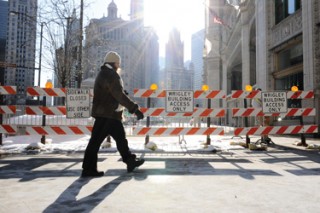Construction to affect pedestrians

January 26, 2009
Chicago’s landmark Michigan Avenue Bridge that crosses the Chicago River and links the Loop to the Near North Side is getting a makeover, which will cause pedestrians to see a disruption in traffic patterns due to the construction for the next six months.
The Michigan Avenue Bridge, built in 1920, is one of the most heavily traveled bridges in the city, with more than 30,000 pedestrians crossing it on an average weekday. The sidewalks are about 20 years old, and the handrails date back about 40 years . Both are deteriorated and in need of replacement, said Brian Steele, spokesperson for the Chicago Department of Transportation.
The upper-level sidewalks are being replaced with a sturdy fiberglass material that is more durable, has better traction and is more slip-resistant than the existing metal surface. The new material will make it easier for pedestrians to cross the bridge during times of snow, ice and rain.
“The Department of Transportation has had success with the fiberglass sidewalk material on the Madison and Harrison Street bridges,” Steele said. “Both bridges have a heavy volume of pedestrian traffic.”
The $3.5 million project has been in the works for years, Steele said. Funding is being provided by Central Loop tax increment financing, which is a way for communities to jumpstart development by borrowing against increased property taxes the projects will produce in the future.
Work began on the bridge’s sidewalks and handrails on Jan. 12 for the first of four phases in the bridge’s construction. During each phase, the sidewalk on one side of the bridge will be closed.
“Pedestrian safety is our No. 1 concern,” Steele said. “We put up extensive signs and barricades. During the first week of each new phase, we will have personnel standing out there directing pedestrians.”
The west sidewalk will be closed to pedestrians from January to late March and the east sidewalk will be closed from March until mid-June, when the project is expected to be completed. Pedestrians will be able to cross Michigan Avenue on the north side in front of the Wrigley Building and on the south side along Wacker Drive.
Steele said the construction will have a minor effect on car traffic as well. During each phase of the project, portions of the outside curb lane will be closed. Currently, a portion of the curb lane on the north end of the bridge is closed, but vehicles can still make a right turn onto Wacker Drive.
“There will be a similar impact when work switches to the east side of the bridge,” Steele said.
While it might seem odd to begin a construction project in the middle of one of Chicago’s coldest months of the year, Steele said it was the best time to handle this type of construction because there are fewer pedestrians walking over the bridge in the winter.
Jeanette Moore, 29, lives in the South Loop and crosses the Michigan Avenue bridge every day to get to her job in the John Hancock Center. She said the construction will be an inconvenience, but she thinks it is important to make it safer to walk across.
“I cannot count the number of times I have nearly fallen down crossing the bridge when it’s snowing,” Moore said. “It’s about time the city did something to make the bridge less slippery.”
In addition to making the bridge more pedestrian-friendly for the winter, the city also plans to add decorative railings that replicate the original 1920s Beaux Arts interlaced diamond pattern designed by Chicago architect Edward Bennett. .New guardrails, lighting and flagpoles will be installed as well.
Victor Pinewski, 47, lives and works as a security guard in Chicago and said he was pleased with the city’s plans to pay tribute to the original bridge designs.
“I like the idea of [the city] restoring the original look of the bridge,” Pinewski said. “It’s a big part of the city’s history.”







